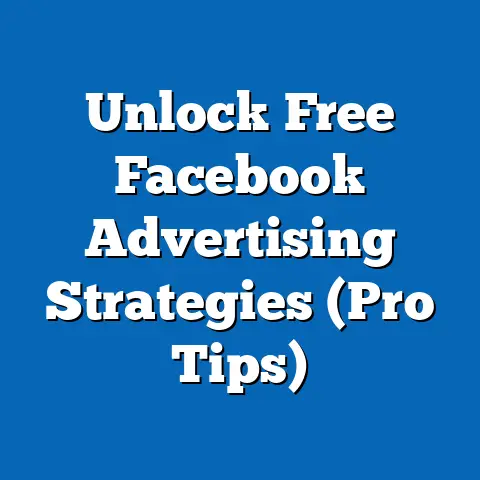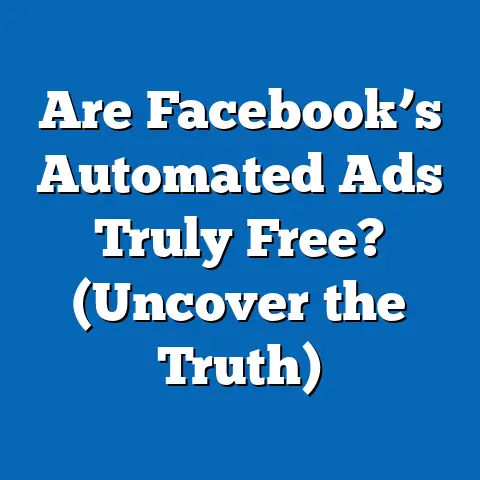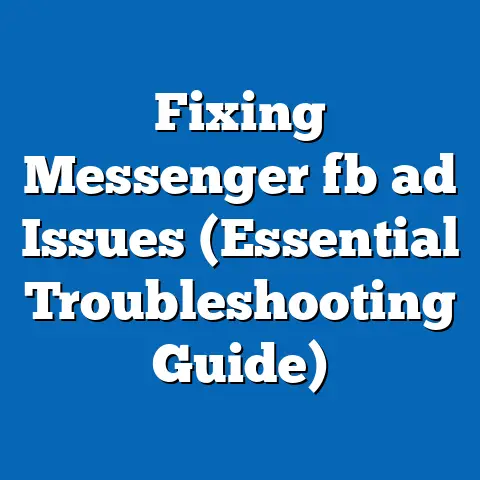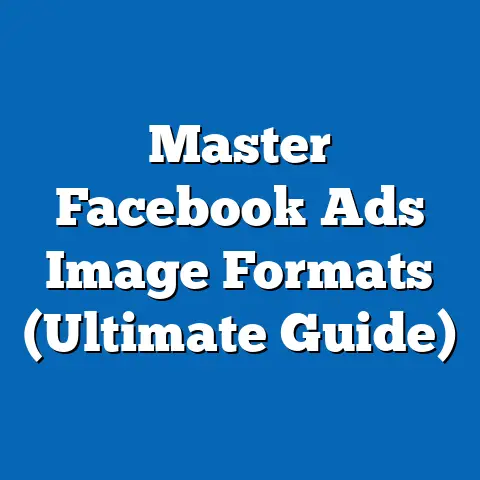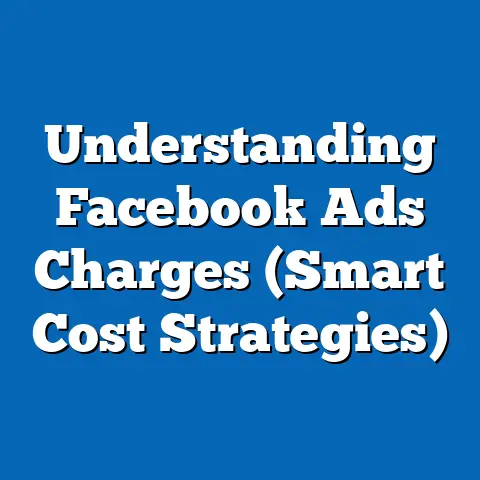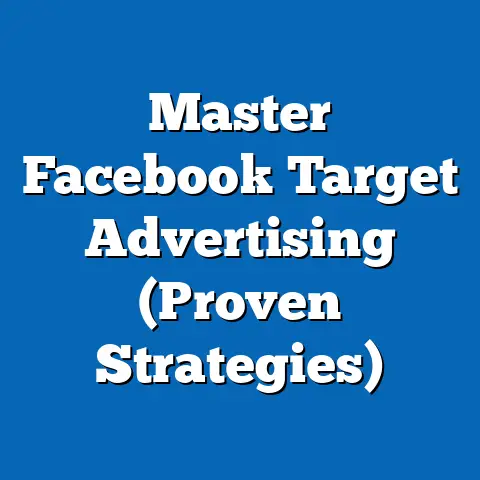Boost Engagement with the Best Font for Facebook Ads (Pro Tips)
Have you ever scrolled through Facebook and noticed how some ads instantly grab your attention while others just seem to fade into the background? I’ve definitely been there, both as a user and as a marketer. While compelling visuals and persuasive copy are crucial, there’s a subtle yet powerful element at play: typography. The font you choose for your Facebook ads can significantly impact engagement and conversion rates. Think of it as the voice of your message – is it clear, trustworthy, and captivating? Or is it muddled, confusing, and easily ignored?
In this article, I’m going to guide you through the world of fonts and how they relate to Facebook advertising. We’ll explore the psychology behind fonts, categorize different types, share best practices for font selection, introduce helpful tools, analyze successful case studies, and even peek into the future of typography in digital ads. By the end, you’ll have a solid understanding of how to choose the best fonts to make your Facebook ads not just seen, but truly engaged with.
The Psychology of Fonts: More Than Just Pretty Letters
Fonts are more than just a way to display text; they’re a form of visual communication that evokes emotions and perceptions. Think about it: a playful, bubbly font might be perfect for a children’s toy ad, but it would feel completely out of place for a financial services company. Understanding the psychology of fonts is crucial for crafting ads that resonate with your target audience.
How Fonts Evoke Emotions and Perceptions
Each font carries its own unique personality. Serif fonts (like Times New Roman or Georgia), with their small decorative strokes, often convey a sense of tradition, authority, and trustworthiness. Sans-serif fonts (like Arial or Helvetica), on the other hand, are generally perceived as modern, clean, and approachable. Script fonts (like Brush Script or Pacifico) can evoke elegance, creativity, or a personal touch, while display fonts are designed to be eye-catching and attention-grabbing.
I remember working on a campaign for a local bakery. Initially, we used a standard sans-serif font for the ad copy. While the ad looked clean, it felt a bit sterile and didn’t capture the warmth and deliciousness of the bakery’s products. After switching to a slightly more playful script font, we saw a noticeable increase in engagement. The font helped to create a more inviting and mouthwatering impression.
Typography’s Role in Branding and Consumer Behavior
Typography is a fundamental element of branding. Just as a logo or color palette defines a brand’s visual identity, font choices contribute to its overall personality and messaging. Consider Coca-Cola’s Spencerian script or the bold, geometric font used by Adidas. These fonts are instantly recognizable and associated with the brand’s values and image.
Studies have shown that font choices can influence consumer behavior. For example, a study published in the Journal of Consumer Psychology found that people perceive products advertised with rounder fonts as being more comfortable and approachable, while products advertised with sharper fonts are seen as more durable and reliable. This highlights the importance of aligning your font choices with the desired brand perception and product attributes.
Real-World Impact: Studies and Surveys
Several studies have investigated the impact of fonts on user engagement and decision-making. One study, conducted by Wichita State University, found that participants rated websites using easy-to-read fonts as more trustworthy and professional compared to websites using less legible fonts. This underscores the importance of readability, especially in the context of online advertising where you have limited time to capture attention.
Another study, published in the International Journal of Advertising, explored the impact of font size on ad effectiveness. The results indicated that larger font sizes tend to increase ad recall and brand recognition, particularly for visually cluttered environments like social media feeds.
Key Takeaway: Font psychology is a real thing! Understanding how different fonts evoke emotions and perceptions is crucial for crafting Facebook ads that resonate with your target audience and align with your brand identity. Next, we’ll break down the different types of fonts and how they can be used effectively.
Types of Fonts and Their Uses: A Visual Guide
Now that we’ve explored the psychology behind fonts, let’s dive into the different types of fonts and how they can be used effectively in Facebook ads. Understanding these categories will help you make informed decisions when selecting fonts for your campaigns.
Serif Fonts: Classic and Trustworthy
Serif fonts are characterized by the small decorative strokes (serifs) at the end of each letter. They often convey a sense of tradition, authority, and trustworthiness.
- Examples: Times New Roman, Georgia, Garamond
- Suitable Contexts:
- Ads for established brands or companies with a long history.
- Ads promoting products or services that emphasize quality, reliability, or expertise.
- Headlines that require a formal or sophisticated tone.
Visual Example: Imagine an ad for a law firm using a serif font like Garamond. The font choice reinforces the firm’s reputation for experience and trustworthiness.
Sans-Serif Fonts: Modern and Approachable
Sans-serif fonts lack the decorative strokes found in serif fonts. They are generally perceived as modern, clean, and approachable.
- Examples: Arial, Helvetica, Open Sans, Roboto
- Suitable Contexts:
- Ads for tech companies or innovative products.
- Ads targeting younger audiences.
- Body text that requires high readability on screens.
- Ads with a minimalist or contemporary design.
Visual Example: Think of an ad for a new mobile app using a sans-serif font like Roboto. The font choice reflects the app’s modern and user-friendly design.
Script Fonts: Elegant and Creative
Script fonts resemble handwriting and often convey elegance, creativity, or a personal touch.
- Examples: Brush Script, Pacifico, Lobster
- Suitable Contexts:
- Ads for creative businesses like bakeries, boutiques, or event planners.
- Ads targeting a female audience (depending on the specific font).
- Headlines that require a touch of personality or flair.
Visual Example: Picture an ad for a handmade jewelry store using a script font like Pacifico. The font choice adds a touch of artistry and craftsmanship.
Caution: Use sparingly! Script fonts can be difficult to read in large blocks of text.
Display Fonts: Eye-Catching and Attention-Grabbing
Display fonts are designed to be visually striking and attention-grabbing. They often feature unique shapes, bold strokes, or unconventional designs.
- Examples: Impact, Bebas Neue, Montserrat
- Suitable Contexts:
- Headlines that need to stand out.
- Ads for special promotions or limited-time offers.
- Ads targeting a specific niche or demographic.
Visual Example: Envision an ad for a concert featuring a display font like Bebas Neue. The font choice conveys excitement and energy.
Caution: Display fonts should be used sparingly and paired with more legible fonts for body text.
Monospaced Fonts: Technical and Uniform
Monospaced fonts have the same width for each letter, creating a uniform and often technical appearance.
- Examples: Courier New, Monaco
- Suitable Contexts:
- Ads for software companies or tech-related products.
- Ads displaying code snippets or technical information.
- Creating a retro or vintage aesthetic.
Visual Example: Imagine an ad for a coding bootcamp using a monospaced font like Courier New. The font choice reinforces the technical nature of the program.
Key Takeaway: Each font type has its own unique personality and is best suited for specific contexts. By understanding these categories, you can make informed decisions when selecting fonts for your Facebook ads and create a visual message that resonates with your target audience. Now, let’s move on to the best practices for font selection.
Best Practices for Font Selection in Facebook Ads: Readability, Brand Alignment, and More
Choosing the right font for your Facebook ad is more than just picking something that looks nice. It’s about ensuring readability, aligning with your brand, creating visual contrast, and pairing fonts effectively. Let’s dive into the best practices to help you make the right choices.
Legibility: Readability at Various Screen Sizes
The most important aspect of font selection is legibility. If your target audience can’t easily read your ad copy, they’re not going to engage with it. Consider the following:
- Font Size: Ensure your font size is large enough to be easily read on mobile devices, where most Facebook users browse. As a general rule, aim for a minimum font size of 16 pixels for body text.
- Line Height: Adjust the line height (the vertical space between lines of text) to improve readability. A line height of 1.4 to 1.6 times the font size is generally recommended.
- Letter Spacing: Adjust the letter spacing (the horizontal space between letters) to prevent overcrowding or excessive gaps.
- Font Weight: Choose a font weight (e.g., light, regular, bold) that provides sufficient contrast without being overwhelming.
I once ran a campaign where the font size was too small, and the line height was too tight. The ad looked cluttered and difficult to read, especially on mobile devices. After increasing the font size and adjusting the line height, we saw a significant improvement in click-through rates.
Brand Alignment: Choosing Fonts That Reflect Your Identity
Your font choices should align with your brand identity and values. Consider the following:
- Brand Personality: Does your brand convey a sense of tradition, innovation, playfulness, or sophistication? Choose fonts that reflect these qualities.
- Brand Consistency: Use the same fonts across all your marketing materials to maintain brand consistency.
- Target Audience: Consider the preferences and expectations of your target audience. What fonts are they likely to find appealing and trustworthy?
For instance, if you’re advertising a luxury brand, you might opt for a sophisticated serif font with elegant letterforms. If you’re advertising a tech startup, you might choose a modern sans-serif font with a clean and minimalist design.
Contrast: Creating Visual Hierarchy for Better Visibility
Contrast is crucial for creating a visual hierarchy and guiding the viewer’s eye through your ad. Consider the following:
- Text and Background: Ensure there’s sufficient contrast between your text and background. Dark text on a light background (or vice versa) is generally the most legible option.
- Font Weight: Use different font weights to emphasize key words or phrases. For example, you might use a bold font for the headline and a regular font for the body text.
- Font Size: Use different font sizes to create a visual hierarchy. Larger fonts for headlines and smaller fonts for body text.
- Color: Use contrasting colors to highlight important elements of your ad. However, be mindful of colorblindness and ensure your color choices are accessible to everyone.
I’ve seen ads where the text color was too similar to the background color, making it difficult to read. By simply adjusting the text color to create more contrast, the ad became much more effective.
Font Pairing: Harmonious Designs for Visual Appeal
Font pairing involves combining two or more fonts in a way that creates a harmonious and visually appealing design. Consider the following:
- Contrast: Choose fonts that contrast each other in terms of style, weight, or size.
- Hierarchy: Use different fonts for headlines and body text to create a visual hierarchy.
- Readability: Ensure that both fonts are legible and easy to read.
- Simplicity: Avoid using too many fonts in a single ad. Two or three fonts are usually sufficient.
Some popular font pairings include:
- Roboto (Sans-Serif) + Montserrat (Sans-Serif): A clean and modern pairing that works well for tech companies.
- Playfair Display (Serif) + Montserrat (Sans-Serif): A sophisticated and elegant pairing that’s suitable for luxury brands.
- Oswald (Sans-Serif) + Lora (Serif): A versatile pairing that works well for a variety of industries.
Visual Example: An ad for a travel agency might use Playfair Display for the headline (“Explore the World”) and Montserrat for the body text (“Book Your Dream Vacation Today”).
Key Takeaway: Font selection is a critical aspect of Facebook ad design. By following these best practices, you can ensure that your ads are legible, visually appealing, and aligned with your brand identity. Next, we’ll explore some tools and resources that can help you find and test fonts.
Tools and Resources for Font Selection: Find Your Perfect Match
Finding the perfect font for your Facebook ad can feel overwhelming with so many options available. Thankfully, there are numerous online tools and resources to help you discover, test, and implement the ideal typography for your campaigns.
Google Fonts: A Free and Extensive Library
Google Fonts is a fantastic resource for finding free, open-source fonts that you can use in your Facebook ads. It offers a vast library of fonts, ranging from classic to modern, serif to sans-serif, and everything in between.
-
Features:
- Extensive font library with thousands of options.
- Font filtering by category, style, and language.
- Font pairing suggestions.
- Downloadable font files for offline use.
- Easy integration with websites and design tools.
-
How to Use:
- Visit the Google Fonts website (https://fonts.google.com/).
- Browse the font library or use the search bar to find specific fonts.
- Click on a font to view its details and download the font files.
- Upload the font files to your design software or website.
Adobe Fonts: High-Quality Fonts for Creative Professionals
Adobe Fonts (formerly Typekit) is a subscription-based service that provides access to a vast library of high-quality fonts from renowned type foundries. It’s a great option for creative professionals who need a wide range of fonts for their design projects.
-
Features:
- Extensive font library with thousands of options.
- High-quality fonts from renowned type foundries.
- Seamless integration with Adobe Creative Cloud applications.
- Easy font syncing across devices.
- Unlimited font usage for personal and commercial projects.
-
How to Use:
- Subscribe to Adobe Creative Cloud and activate Adobe Fonts.
- Browse the font library within your Adobe Creative Cloud application (e.g., Photoshop, Illustrator).
- Activate the fonts you want to use.
- The fonts will be automatically synced to your computer and available in your design software.
Font Pair: Discovering Harmonious Font Combinations
Font Pair is a website that helps you discover harmonious font combinations for your design projects. It features curated font pairings that are visually appealing and easy to read.
-
Features:
- Curated font pairings that are visually appealing and easy to read.
- Font pairing suggestions for various design styles and industries.
- Information about each font, including its history and characteristics.
- Links to download the fonts from Google Fonts.
-
How to Use:
- Visit the Font Pair website (https://fontpair.co/).
- Browse the font pairings or use the search bar to find specific combinations.
- Click on a font pairing to view its details and download the fonts from Google Fonts.
A/B Testing: Measuring Font Effectiveness
A/B testing is a powerful technique for measuring the effectiveness of different font choices in your Facebook ads. By creating two versions of your ad with different fonts and tracking their performance, you can determine which font resonates best with your target audience.
- How to A/B Test Fonts:
- Create two versions of your Facebook ad with different fonts.
- Ensure that all other elements of the ad (e.g., copy, images, targeting) are identical.
- Run the ads simultaneously and track their performance metrics (e.g., click-through rate, conversion rate).
- Analyze the results to determine which font performed better.
- Use the winning font in your future ad campaigns.
I always recommend A/B testing, especially when you’re unsure about which font to use. It’s a data-driven way to make informed decisions and optimize your ad performance.
Audience Feedback: Getting Insights from Your Target Market
In addition to A/B testing, it’s also helpful to gather feedback from your target audience about your font choices. You can do this through surveys, polls, or focus groups.
- How to Get Audience Feedback:
- Create a survey or poll asking your target audience about their font preferences.
- Show them examples of different fonts and ask them to rate their appeal and readability.
- Gather feedback from your target audience through focus groups or informal conversations.
- Use the feedback to inform your font selection decisions.
Key Takeaway: Numerous tools and resources are available to help you find and test fonts for your Facebook ads. By leveraging these resources and gathering feedback from your target audience, you can make informed decisions and optimize your ad performance. Now, let’s analyze some case studies of successful Facebook ads.
Case Studies of Successful Facebook Ads: Font Choice in Action
Let’s take a look at some real-life examples of successful Facebook ad campaigns and analyze the font choices that contributed to their effectiveness. By examining these case studies, we can learn valuable lessons that you can apply to your own ad campaigns.
Case Study 1: Airbnb
Airbnb is known for its visually appealing and user-friendly Facebook ads. In this example, Airbnb uses a clean and modern sans-serif font (likely Circular, their custom font) for both the headline and body text.
-
Font Choice Rationale:
- The sans-serif font conveys a sense of modernity, approachability, and trustworthiness, which aligns with Airbnb’s brand identity.
- The font is highly legible, even on mobile devices, ensuring that users can easily read the ad copy.
- The use of a single font creates a clean and consistent visual experience.
-
Results:
- The ad achieved a high click-through rate and conversion rate.
- The font choice contributed to the overall user-friendly and trustworthy impression of the ad.
-
Lessons Learned:
- Choose fonts that align with your brand identity and values.
- Prioritize legibility, especially on mobile devices.
- Consider using a custom font to create a unique and memorable brand experience.
Case Study 2: Nike
Nike’s Facebook ads are known for their bold and impactful visuals. In this example, Nike uses a strong and athletic sans-serif font (likely Futura or a similar geometric font) for the headline and body text.
-
Font Choice Rationale:
- The sans-serif font conveys a sense of athleticism, energy, and confidence, which aligns with Nike’s brand identity.
- The bold font weight emphasizes the key message and creates a sense of urgency.
- The use of a single font creates a consistent and impactful visual experience.
-
Results:
- The ad achieved a high engagement rate and brand awareness.
- The font choice contributed to the overall impactful and motivating impression of the ad.
-
Lessons Learned:
- Choose fonts that convey the desired emotions and associations.
- Use font weight to emphasize key messages and create a sense of urgency.
- Consider using a bold font for headlines to grab attention.
Case Study 3: Sephora
Sephora’s Facebook ads are known for their elegant and sophisticated visuals. In this example, Sephora uses a stylish serif font (likely a modern serif like Playfair Display) for the headline and a clean sans-serif font (likely Open Sans) for the body text.
-
Font Choice Rationale:
- The serif font conveys a sense of elegance, sophistication, and luxury, which aligns with Sephora’s brand identity.
- The sans-serif font provides high readability for the body text.
- The font pairing creates a visual hierarchy and adds visual interest to the ad.
-
Results:
- The ad achieved a high click-through rate and conversion rate.
- The font choice contributed to the overall elegant and sophisticated impression of the ad.
-
Lessons Learned:
- Consider using a serif font for headlines to convey a sense of elegance and sophistication.
- Pair serif fonts with sans-serif fonts to create a visual hierarchy and add visual interest.
- Ensure that both fonts are legible and easy to read.
Key Takeaway: These case studies demonstrate the importance of font choice in creating effective Facebook ads. By analyzing successful ad campaigns and understanding the rationale behind their font choices, you can learn valuable lessons that you can apply to your own ad campaigns. Let’s move on to future trends in typography.
Future Trends in Typography for Facebook Ads: What’s on the Horizon
The world of typography is constantly evolving, and new trends are emerging that could significantly impact Facebook advertising in the future. Let’s explore some of these trends and how they might affect user engagement and advertising strategies.
The Rise of Variable Fonts
Variable fonts are a relatively new font technology that allows for greater flexibility and customization compared to traditional fonts. With variable fonts, you can adjust various parameters, such as weight, width, and slant, to create a wide range of font variations from a single font file.
- Potential Impact on Facebook Ads:
- Greater design flexibility and customization.
- Reduced file sizes and improved website performance.
- More engaging and interactive ad experiences.
- Personalized font experiences based on user preferences.
I believe variable fonts will become increasingly popular in the future as designers and advertisers seek more creative control and flexibility.
Custom Typography: Unique Branding Opportunities
Custom typography involves creating unique fonts specifically for a brand. This allows for a highly distinctive and memorable brand identity that sets the brand apart from its competitors.
- Potential Impact on Facebook Ads:
- Stronger brand recognition and recall.
- Enhanced brand personality and messaging.
- Improved user engagement and brand loyalty.
- Competitive advantage through unique visual branding.
While custom typography can be expensive, it’s a worthwhile investment for brands that want to create a truly unique and memorable identity.
Integration of Motion Typography in Digital Ads
Motion typography involves animating text to create visually dynamic and engaging ad experiences. This can be achieved through various techniques, such as kinetic typography, animated typefaces, and text-based animations.
- Potential Impact on Facebook Ads:
- Increased attention and engagement.
- Enhanced storytelling and messaging.
- Improved brand recall and memorability.
- More immersive and interactive ad experiences.
I’ve seen some incredibly creative examples of motion typography in digital ads, and I believe this trend will continue to grow in the future.
AI-Powered Font Selection
Artificial intelligence (AI) is increasingly being used to automate and optimize various aspects of design, including font selection. AI-powered tools can analyze ad copy, brand identity, and target audience data to suggest the most appropriate fonts for a given campaign.
- Potential Impact on Facebook Ads:
- Faster and more efficient font selection.
- Data-driven font choices based on performance metrics.
- Personalized font recommendations based on user preferences.
- Improved ad performance and ROI.
Key Takeaway: The future of typography in Facebook ads is likely to be characterized by greater flexibility, customization, and automation. By staying informed about these emerging trends and adopting new technologies, you can create more engaging and effective ad campaigns. Finally, let’s wrap things up with a conclusion.
Conclusion: The Power of Typography in Facebook Advertising
We’ve covered a lot of ground in this article, from the psychology of fonts to best practices for font selection, tools and resources, case studies, and future trends. I hope you now have a solid understanding of the importance of typography in Facebook advertising and how to choose the best fonts to boost engagement.
Remember, your font choices can significantly impact how your ads are perceived and whether they resonate with your target audience. By prioritizing legibility, aligning with your brand identity, creating visual contrast, and pairing fonts effectively, you can create ads that are not only visually appealing but also highly effective.
I encourage you to experiment with different font selections in your own Facebook ads and track their performance. A/B testing is a powerful tool for determining which fonts resonate best with your target audience and drive the best results.
Don’t underestimate the power of typography. It’s a subtle yet powerful element that can make a big difference in your advertising success. Now, go out there and create some stunning Facebook ads that capture attention, convey your message effectively, and drive results! What fonts will you choose to make your next campaign a success?

